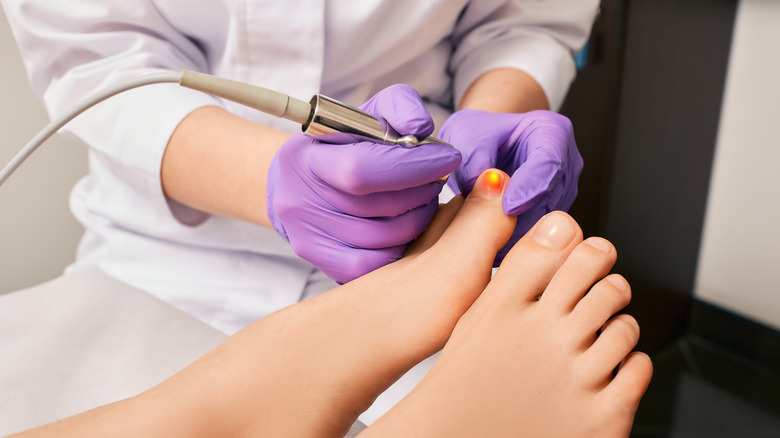Is Laser Therapy Effective For Toenail Fungus?
Toenail fungus, also called "onychomycosis," is a common fungal infection that affects the nail bed and surrounding tissues. Just like athlete's foot, it is caused by a group of fungi known as "dermatophytes," which thrive in warm, moist environments such as the inside of shoes, per the Mayo Clinic. In some cases, it can lead to complications such as cellulitis, a bacterial skin infection that can spread to other body parts, says the Cleveland Clinic.
Toenail fungus is more common in older adults and people with certain medical conditions, such as diabetes or a weakened immune system, per the Centers for Disease Control and Prevention (CDC). Signs and symptoms which indicate that a toenail is infected with fungus may include thickening, discoloration, brittleness or crumbling, deformation, foul odor, separation from the nail bed, and pain or swelling.
There are various treatment options for toenail fungus, and laser therapy seems promising.
How effective is laser therapy for toenail fungus?
Laser therapy is a relatively new treatment option for toenail fungus. This treatment targets the fungus with high-intensity light, which heats and destroys the organism without damaging the surrounding tissue. The procedure typically takes less than an hour and is performed on an outpatient basis, says the Cleveland Clinic.
While some studies have shown promising results, more research is needed to determine its effectiveness and safety. Several small studies have suggested that laser therapy may effectively treat toenail fungus. In a 2019 study published in the journal Medicine, researchers found that laser therapy was effective but concluded that C02 lasers were more effective than other types. The study also warned of potential side effects such as pain and bleeding. Another 2018 study found in the European Journal of Medical Research revealed that laser therapy might be more effective with traditional treatments, such as antifungal or topical treatments.
While laser therapy may be a promising treatment option for toenail fungus, it is vital to discuss all treatment options with your doctor to determine the best way forward.
Other ways to treat toenail fungus
Besides laser therapy, toenail fungus can be treated with various methods, including topical and oral antifungal medications and surgical nail removal in severe cases. Oral antifungal medications are usually the first line of treatment, says the Mayo Clinic. These medications are taken by mouth for several weeks or months and attack the fungus from within the body. Examples of oral antifungal medications include terbinafine and fluconazole, per the Cleveland Clinic. Oral antifungal medications can be effective in clearing the infection but may have side effects such as liver damage, so they should be taken under the supervision of a doctor.
Topical antifungal medications applied directly to the affected toenail may also be helpful. However, they may be more effective when used alongside oral medications, says the Cleveland Clinic.
Surgical removal of the infected nail may be necessary for severe toenail fungus that does not respond to other treatments. This procedure usually involves removing the entire nail or only the infected part of the nail, per the Mayo Clinic.



